
Rhodocoma : planting, growing and care
Contents
Rhodocoma in a nutshell
- Rhodocomas are unique plants appreciated for their elegant, spreading silhouette.
- They form large, light, and airy clumps made up of slender, leafless stems.
- These are tall, structural, architectural perennials, resembling reeds.
- They thrive in full sun in well-drained, rather poor, neutral to acidic soil.
- They can also be grown in pots to adorn a terrace.
The word from our expert
Rhodocoma are majestic perennials native to South Africa, with a silhouette reminiscent of reeds. They form large, upright clumps, reaching between 1 m and 2.50 m in height, composed of long, gracefully arched stems. They are highly ornamental. These little-known, original, and surprising plants have the advantage of adding height and structure to flower beds. They integrate perfectly into exotic-style beds, alongside other southern hemisphere plants, or in contemporary gardens. Rhodocoma are restios, like Elegia capensis and Thamnocortus.
Rhodocoma thrive in full sun and warmth. They can be grown in the ground if winters are not too cold (they tolerate temperatures between -8 and -12 °C). They are well-suited to the Mediterranean climate or the Atlantic coast and are particularly ideal for seaside gardens, especially as they withstand wind and salt spray. In cooler regions, such as north of the Loire, Rhodocoma can easily be grown in large pots or containers and placed on the terrace. Simply bring them indoors for winter to protect them from the cold. As for the substrate, they prefer well-drained, rather poor, neutral to acidic soil. Once established, Rhodocoma require little attention. Discover all our tips for successful cultivation, whether in the ground or in pots, in this guide!
botany
Botanical data
- Latin name Rhodocoma sp.
- Family Restionaceae
- Common name Restio
- Flowering between May and July
- Height between 1 m and 2.50 m, up to 3 m
- Sun exposure full sun
- Soil type well-draining, rather poor, neutral to acidic
- Hardiness between – 8 °C and – 12 °C.
Rhodocoma comprises 8 species native to South Africa, mainly from the Cape region. They are found particularly in the fynbos, a characteristic plant formation with a Mediterranean climate and poor soils low in organic matter, where many Proteaceae, Restionaceae, and Ericaceae grow, along with succulents, bulbous plants, and Asteraceae… Rhodocoma are still rare in gardens, despite their ornamental qualities. The most commonly cultivated species are Rhodocoma capensis and Rhodocoma gigantea.
Rhodocoma is one of the plants commonly referred to as Restio, like Elegia capensis or Thamnocortus, as they belong to the Restionaceae family. These are herbaceous monocotyledonous plants, comprising over 400 species native to the Southern Hemisphere (South Africa, Australia, New Zealand, Madagascar, Chile…). Discover our full range of restios by clicking here.
Etymologically, the name “restio” comes from the Latin restis: “rope,” as the sturdy stems of some species were used to make ropes. Similarly, some restios were used for thatched roofs or brooms… As for the name Rhodocoma, it derives from the Greek rhodo: rose, and kome: hair, alluding to the pink, feathery flowers of female plants. Rhodocoma capensis was named for its origin in the former Cape Province of South Africa (which today corresponds to roughly half of South Africa’s territory).
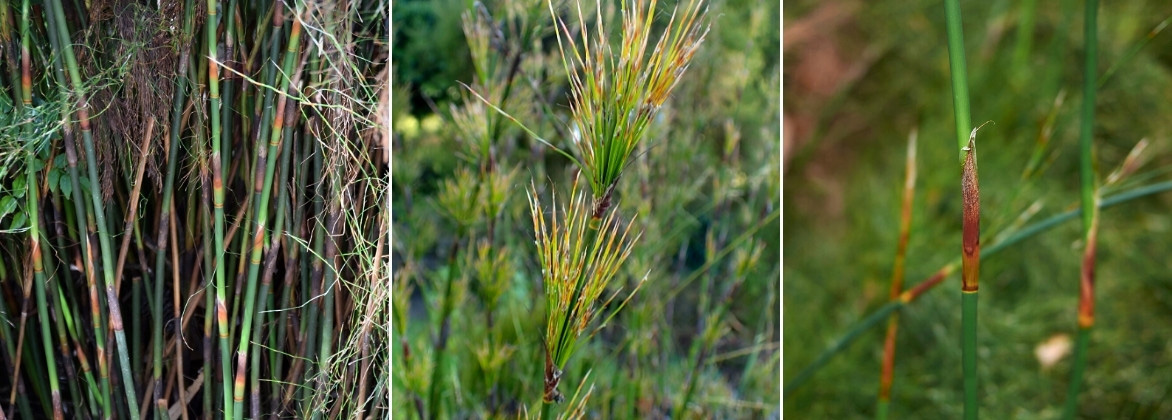
Detail of the stems of Rhodocoma capensis. They do not bear true leaves: these are reduced to brown scales at the nodes. (photos: Krzysztof Golik / Krzysztof Ziarnek / Adobe Stock)
Rhodocoma are large perennials with a dense habit, forming clumps of upright stems. These stems are long, sturdy, and beautifully flared, giving the plant a very elegant appearance. They are arched and inclined in young plants but become increasingly straight and erect over time. Their silhouette resembles that of reeds or tall grasses like Miscanthus. Rhodocoma capensis grows between 1 and 2 m tall, while Rhodocoma gigantea can reach 2.50 m – 3 m in height. Their stems are sturdy with well-marked nodes, like bamboo, from which numerous fine, feathery, and dense branches emerge. This gives Rhodocoma a very graphic and airy style. Like horsetails, Rhodocoma do not have true leaves: they are reduced to small brown scales at the nodes. The green stems perform photosynthesis. The absence of leaves is an adaptation to drought: it limits evapotranspiration and thus water loss.
Rhodocoma flower in late spring or early summer, between May and July, depending on the climate and species. Rhodocoma plants are either male or female, producing different inflorescences. Female inflorescences are short and upright, with flowers bearing pink, feathery styles, while male inflorescences are long and arched, with brown spikelets drooping toward the ground.
As with other Restionaceae, pollination is wind-driven, carrying pollen from male plants to female flowers. This explains why Restio flowers are discreet, not very colourful or fragrant… as flower colours and scents primarily serve to attract insects and other animals responsible for pollination.
Rhodocoma produces very small, oval, brown seeds. When mature, they fall to the ground and wait for the right conditions to germinate. In South Africa, fires are frequent in the fynbos: Rhodocoma have naturally adapted, and their seeds require fire to germinate.
Rhodocoma roots are fragile and dislike being moved. Therefore, it is best to choose its location carefully before planting it in the garden.
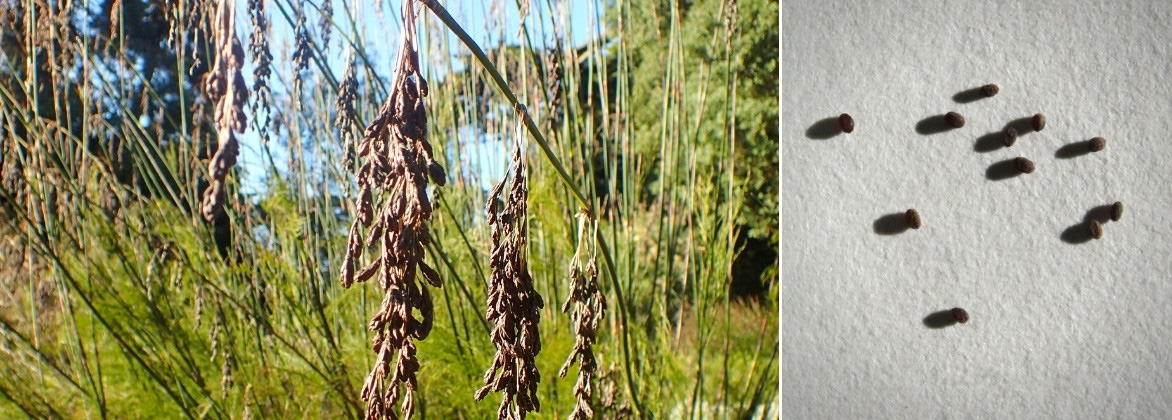
Male inflorescences of Rhodocoma gigantea and seeds of Rhodocoma capensis. (photos: Krzysztof Ziarnek / Omar Hoftun)
The main varieties
The most popular varieties
In cultivation, you will mainly find the two species Rhodocoma capensis and Rhodocoma gigantea.
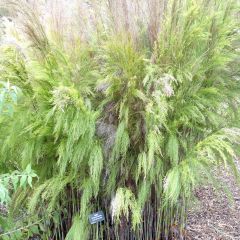
Rhodocoma capensis
- Flowering time June, July
- Height at maturity 1,50 m
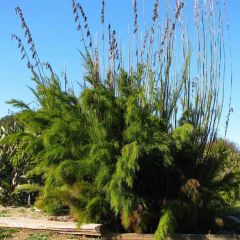
Rhodocoma gigantea - Restio
- Flowering time July, August
- Height at maturity 2,50 m
Also discover other Restios, which are very close to Rhodocoma.
Discover other Rhodocoma
View all →
Available in 1 sizes
Available in 1 sizes
Planting
Where to Plant?
Native to South Africa, Rhodocoma thrives in warmth and sunlight. It grows in the fynbos, where the soil is poor in organic matter, rather acidic, clayey, or sandy. In the garden, find it a spot in full sun (though it can also tolerate light shade). Plant it in well-drained, rather poor, neutral or acidic soil. It dislikes heavy, compacted soils that are waterlogged.
Rhodocomas prefer mild climates, not too cold in winter. They are ideal plants for coastal gardens, especially as they withstand wind and sea spray without issue. Once established, they can tolerate temperatures dropping between -8 and -10°C in well-drained soil (or even down to -12°C for Rhodocoma capensis).
Choose their location carefully, as once planted, Rhodocomas dislike being moved. Rhodocomas will find their place, for example, in an exotic border, where their silhouette adds height and structure, or in a garden of southern hemisphere plants. They are highly decorative and architectural plants.
Rhodocomas also adapt well to container cultivation: this makes it easy to bring them under shelter for winter and place them on a terrace for the rest of the year, where they will effortlessly create an exotic and graphic atmosphere. For pot planting, we recommend Rhodocoma capensis, which is more compact than R. gigantea.
When to Plant?
We recommend planting Rhodocoma in spring, around April. In regions with low frost risk, such as the Mediterranean coast, Rhodocoma can also be planted in autumn.
How to Plant?
When planting Rhodocoma, handle it carefully to avoid disturbing its roots too much.
In the ground:
- Start by placing the root ball in a basin of water to rehydrate it.
- Meanwhile, dig a planting hole, about three times the size of the root ball.
- Add some soil mixed with coarse sand to improve drainage.
- Remove the Rhodocoma from its pot and plant it.
- Fill in around it with substrate.
- Water generously.
In a pot:
- Choose a large pot with drainage holes.
- Place a drainage layer at the bottom, such as gravel or clay pebbles.
- Add a mix of potting compost, garden soil, and sand.
- Place the Rhodocoma in the new pot, centred.
- Fill in with substrate, then lightly firm.
- Water generously.
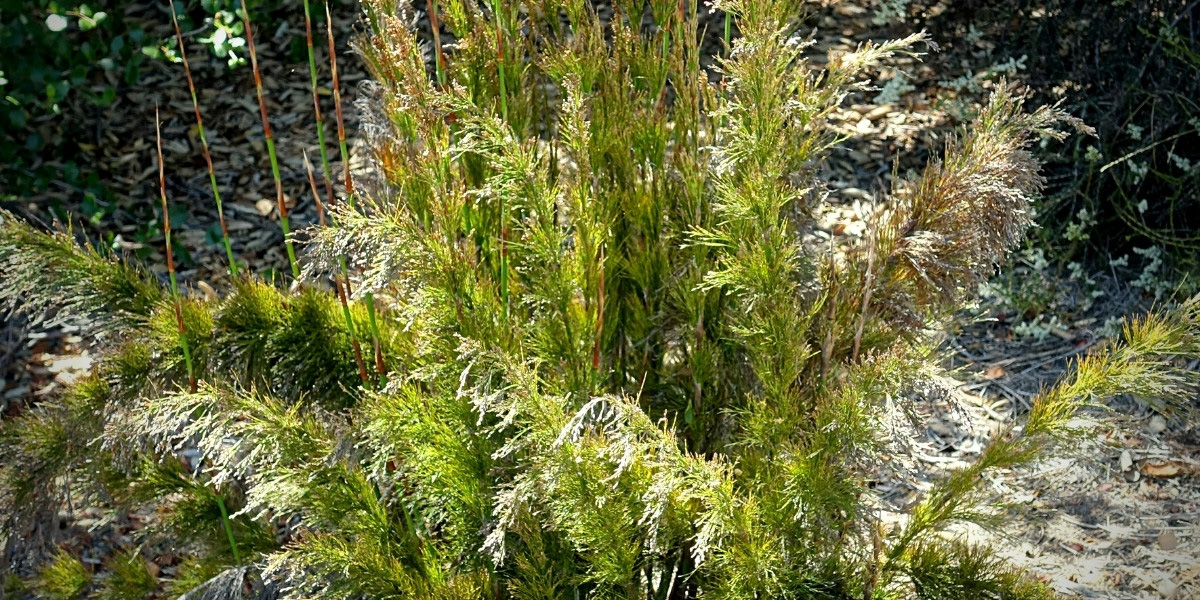
Rhodocoma capensis
Read also
Plant and grow southern plantsMaintenance
Rhodocomas require very little maintenance and are not susceptible to diseases or parasitic issues. However, they will appreciate occasional watering during summer droughts. Preferably, use rainwater rather than tap water, which may be too hard for them. Additionally, consider mulching around the clump, for example with pine bark, to keep the soil moist for longer.
In winter, you can protect the Rhodocoma from the cold by wrapping it in winter fleece and adding a thick layer of mulch around the base of the clump.
If you notice any stems damaged by frost during winter, you can prune them back hard.
Caring for a potted Rhodocoma:
If grown in a pot, don’t hesitate to move it to a frost-free shelter during winter. In spring, place the Rhodocoma on your terrace in full sun.
For potted plants, remember to water them regularly, as the substrate dries out faster than in the ground, but avoid letting water stagnate in the saucer. Reduce watering in autumn and winter.
We recommend repotting the Rhodocoma every two years. This allows you to refresh the substrate and give it more room to grow. In years when you don’t repot, top-dress by removing a little substrate from the top few centimetres and adding fresh compost.
Multiplication
Sowing
Rhodocoma can be propagated from seed. However, these are not easy to harvest as they are small and quickly fall to the ground as soon as they are ripe, and they require specific conditions for germination.
In South Africa, fires are regular in the fynbos, and Rhodocomas have adapted accordingly. It is the passage of fire that breaks the dormancy of their seeds and allows them to germinate. You will therefore need to mimic fire, for example by mixing ashes into the substrate.
- To encourage germination, soak the seeds for 24 hours in water to which you will add a teaspoon of ashes.
- Fill a pot with special sowing compost (or a mixture of compost and sand), to which you will add a little ash.
- Lightly firm and level the surface.
- Sow the seeds.
- Cover them with a thin layer of substrate.
- Water.
Ensure the substrate remains slightly moist until germination.
Division of Clumps
Rhodocoma can also be divided in late winter or early spring.
- Choose a large, well-developed young plant.
- Dig around it to lift it.
- Separate it into several clumps using a spade or pruning shear. Each should be fairly large, as Rhodocoma takes a long time to develop after division.
- Replant in a new location or in a pot.
Association
With their imposing silhouette, Rhodocomas are perfect for creating an exotic-style garden. Pair them with lush vegetation plants, such as palm trees and bamboos, the banana plant Musa basjoo, the Datisca cannabina, Fatsia japonica, and Tetrapanax. This will create a stunning plant display evoking a tropical jungle! For flowering, opt for warm hues (yellow, orange, red, purple…): consider, for example, kniphofias, crocosmias, cannas, and daylilies.
In regions with a relatively cool climate, such as north of the Loire, you can grow Rhodocoma in pots and place them on your terrace to create a beautiful summer display. Choose the Rhodocoma capensis, and place the pot on the terrace alongside other container plants that can be overwintered, such as the Gloriosa superba, the Strelitzia reginae, as well as palm trees, passionflowers, lantanas, abutilons, and cordylines. In autumn, you can move all these plants to a frost-free, bright shelter to protect them from the cold during the winter months.
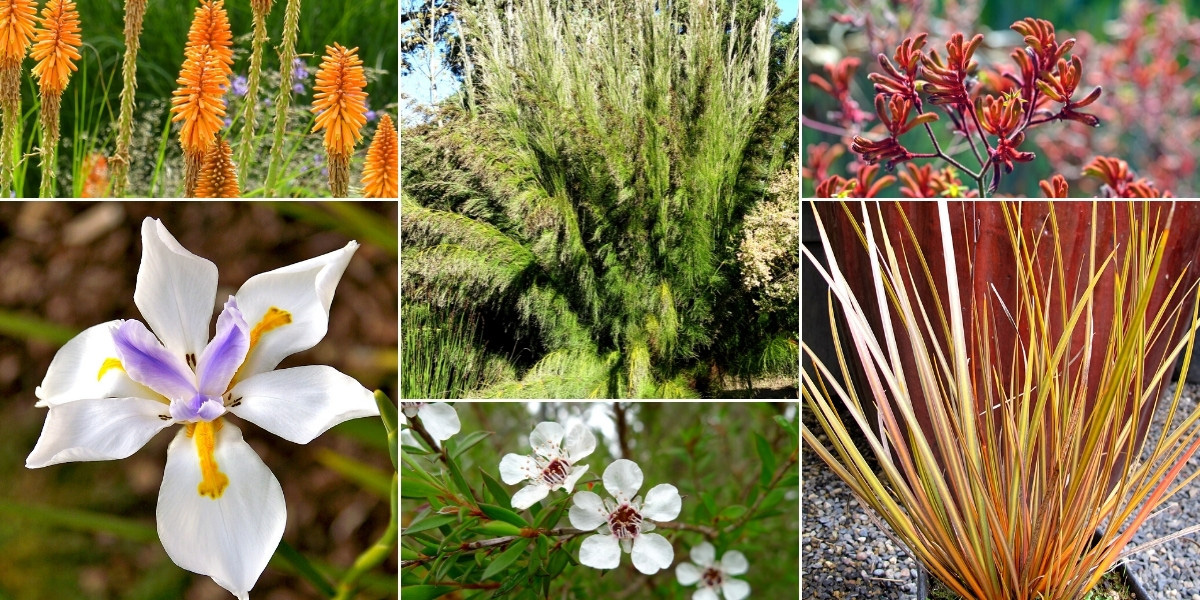
Rhodocoma is perfect for creating an exotic garden with other Australasian plants. Kniphofia ‘Fiery Fred’, Rhodocoma capensis, Anigozanthos, Dietes grandiflora, Leptospermum scoparium (photo J. Tann) and Libertia ixioides ‘Taupo Blaze’ (photo M. Hansen)
Rhodocoma is ideal for creating a garden of Australasian plants. These include plants native to Australia, New Zealand, and South Africa, adapted to hot, dry climates and poor, acidic soils. Consider, for example, proteas, such as Grevillea, Leucadendron, and Protea. Enjoy the highly graphic foliage of the dasylirion, Cordyline australis, Libertia ixioides, and Phormium tenax! For flowering, think of plants like the Watsonia, Dietes grandiflora, Anigozanthos flavidus, and Leptospermum. This will give you a garden that is both graphic and exotic!
For more tips and information, check out our guide “Planting and Growing Australasian Plants”.
Useful resources
- Discover our full range of restios: Rhodocoma, Elegia, Thamnocortus…
- Feel free to check out our guide « Restio, Elegia capensis: Planting, pruning and care »
- Subscribe!
- Contents
































Comments